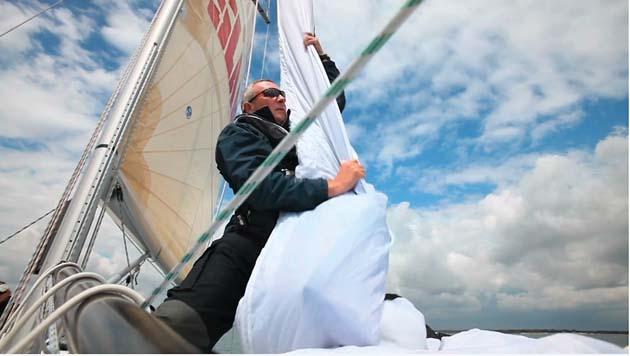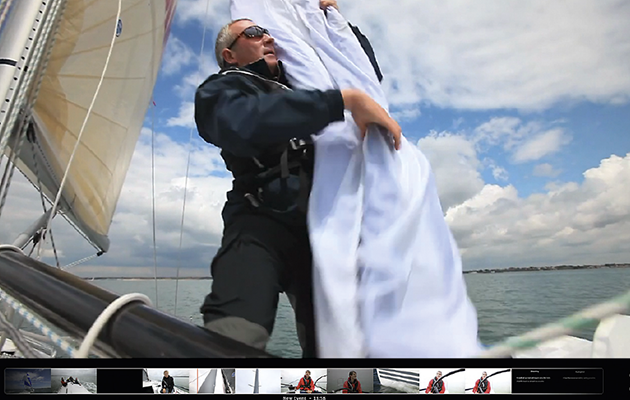It’s a manoeuvre that makes even professional sailors get the jitters, admits Pip Hare. But Part 11 of our series reveals that the spinnaker drop can be simple
![]()
One manoeuvre that really makes my heart race when sailing single-handed is a spinnaker drop. It can seem like a recipe for disaster as I will often be dropping because the wind has increased. One problem and the wind or sea could rip the sail from my hands – game over. Good preparation and a mental rehearsal of the process is my key to success; take it step by step and don’t let anything go until you are sure you are ready.
Here I outline my tips for dropping a spinnaker short-handed or with a novice crew and on the accompanying video you can see me and Hannah Jenner, a former Clipper Race skipper who also won a podium place in the Transat Jacques Vabre 2011, perform a double-handed drop.
See our video of SAIL FASTER SAIL SAFER Part 11
Preparation
Flake all lines involved in the drop: the halyard, guy, tackline and also the lazy sheets if you are using them. The latter are often forgotten, but have the potential to create an unseen knot and a whole heap of problems. Make sure they will run free and are not under anyone’s feet in the cockpit.
It is essential to steer the boat onto a deep downwind course to reduce the apparent wind and therefore the pressure in the spinnaker.
If conditions are very rolly when I am sailing single-handed, I even rig a preventer, which allows me to set the pilot close to dead downwind without the worry of the boom gybing mid-manoeuvre.
Hoisting or unfurling the jib before the drop, provides a natural windbreak to help depower the spinnaker.
Flake lines to prepare:

Symmetric drop
When you have prepared the boat and your crew are ready, ease the guy fairly quickly until the pole is at the forestay. The windward clew will fall around behind the jib and the sail will collapse.
At this point, start to gather in the foot of the sail, letting off the rest of the guy, and ease the halyard. Aim to let off around the top one-fifth of the halyard very quickly – this allows the head of the sail to blow away from the boat and depower just long enough for you to be able to pull the rest of the spinnaker down away from the masthead and into shelter behind the mainsail.
Then let the rest of the halyard out in time with the crew retrieving the sail to keep it out of the water.
If alone or short-handed the fast initial release does not work, so I either leave a wrap of halyard around the winch, using the extra friction to control the speed of the drop, or I throw the halyard out behind the boat, then the drag of the line trailing through the water will have the same effect.
Solo or short-handed, gather the foot all the way into a sausage before releasing the halyard, that way you can pull the whole sail down under control.
Gather foot of sail:

Keep an eye on crew’s progress when easing halyard:

The letterbox
If you have a loose-footed main, a letterbox drop is a safe and easy method, especially if short-handed. Before the drop, pull your lazy guy over the guardrails and pass it between the foot of the mainsail and the boom. Carry out the drop exactly as before, but use the lazy guy to pull the sail down between the boom and the mainsail.
This method has two advantages; first, the spinnaker is pulled in from directly behind the mainsail, meaning it is completely shielded from the wind; and second, the boom gives you an element of purchase, should the sail fill with wind or even water.
I have used the letterbox method when single-handing, including to drop my 108m2 spinnaker alone in some tough conditions.
Asymmetrics and cruising chutes
The same principles apply as for symmetric drops, but the manoeuvre starts with a quick ease of the tackline to allow the tack of the sail to blow off downwind like a flag and depower the sail. Your crew can then pull on the lazy sheet to bring the chute behind the mainsail once the tack is inside the footprint of the boat; the halyard can be released as already described.
Asymmetric sails which fly from a bowsprit are more difficult to depower before the drop because they are further away from the boat in clean air. The initial release of the tackline must be rapid; a slow ease or a snagged line will cause the spinnaker to stay full as it flies away from the boat making it uncontrollable.
Snuffers
Unless it is very windy it is often easier not to hoist the jib when using a snuffer, so you can see clearly the top of the sail.
The basics of the manoeuvre are the same; steer a deep downwind course and prepare the cockpit beforehand. To depower the sail, ease the sheet a little then the guy or tackline as with a normal drop. Once the sail collapses, start pulling the sock down.
In more difficult conditions run the snuffer line through a snatch-block on the foredeck and pull up on it. This will give you a little purchase on the line and make it less likely that you are taken off your feet if a gust fills the sail and forces the snuffer up again. In these sorts of conditions, gloves and a safety harness are also a good idea.
You may also find by pulling the snuffer down from the leeward side and close to the mast you encourage the sail to fall in behind the main and collapse in its shadow.
Once the sock is down, drop the halyard, gathering the sock on the foredeck.
Pull snuffer smoothly:

Top tips
- Don’t simply let go of the halyard: watch the crew too and if the sail is not coming in fast enough, slow down the rate of release.
- When short-handed, take an extra minute to ensure all lines will run snag-free; one knot could ruin your day.
- Think ahead: always be ready for a drop should conditions change, mentally run through the manoeuvre.
- Your autopilot can help out in a drop too. If your pilot has been steering to the wind, reset it to steer in compass mode. Increase the sensitivity by one or two levels to make sure the computer reacts to the sudden change in velocity and will not allow a wave to round you into the wind at the critical moment.
 Single-handed ocean sailor Pip Hare has clocked up thousands of miles racing and cruising. Among her achievements are five solo transatlantics, including the OSTAR and two Mini Transat races. She also works full-time for the RNLI on sea safety and is Consulting Editor on Yachting World. See also her series on short-handed sailing
Single-handed ocean sailor Pip Hare has clocked up thousands of miles racing and cruising. Among her achievements are five solo transatlantics, including the OSTAR and two Mini Transat races. She also works full-time for the RNLI on sea safety and is Consulting Editor on Yachting World. See also her series on short-handed sailing
SAIL FASTER SAIL SAFER Part 12: Pip Hare has some suggestions as to what to do when it all goes wrong and the kite is in the water
12 part series in association with Pantaenius




